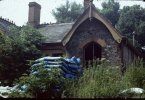LarryG
Western Thunderer
No doubt many modellers have noticed the variety of colours seen in GWR albums in BR days, as well seen on historical models and heritage lines depicting GWR days. I have tried to apply some logic to it all and failed! Even two model paint manufacturers cannot agree on light and dark stone.
Many buildings carry what appears in print to be cream or custard. It could of course be faded light stone, but in pictures that include blood & custard coaches, it is obvious that both 'creams' are similar. Then there is the variety of 'dark stone' shades. Considering the Big Four companies were able to buy ready-mixed colours from at least the 1920's, there is little scope for saying paints were mixed by hand in the 1930 onwards. Or did this continue for some reason?
On Cambrian lines for instance, many buildings were a reddish mid brown and what looked like bleached cream. They were maybe faded GWR Light & Dark stone. True BR dark brown & cream colours are distinctive and could not be mistaken for other colours.
Many buildings carry what appears in print to be cream or custard. It could of course be faded light stone, but in pictures that include blood & custard coaches, it is obvious that both 'creams' are similar. Then there is the variety of 'dark stone' shades. Considering the Big Four companies were able to buy ready-mixed colours from at least the 1920's, there is little scope for saying paints were mixed by hand in the 1930 onwards. Or did this continue for some reason?
On Cambrian lines for instance, many buildings were a reddish mid brown and what looked like bleached cream. They were maybe faded GWR Light & Dark stone. True BR dark brown & cream colours are distinctive and could not be mistaken for other colours.
Last edited:










